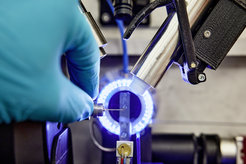X-ray screening identifies promising candidate substances for treatment of COVID
Extensive X-ray screening reveals binding to key virus protein
In contrast to vaccines, which help healthy people to defend themselves against the virus, drug research is looking for drugs that slow down or stop the reproduction of the virus in the body of people who are already infected. Viruses cannot reproduce on their own. Instead, they introduce their own genetic material into the cells of their host and make them produce new viruses. Proteins such as the main protease of the virus play an important role in this process. Protease cuts protein chains produced by the host cell according to the blueprint of the virus genetic material into smaller parts that are necessary for the reproduction of the virus. If the main protease can be blocked, the cycle can possibly be interrupted; the virus can no longer reproduce and the infection is defeated.

Beamline P11 of DESY´s PETRA III research lightsource specialises in structural biology studies. Here, the three-dimensional structure of proteins can be imaged with atomic precision. The research team led by DESY physicist Alke Meents used this special capability to examine several thousand active substances to see whether and how they “dock” to the main protease – the first important step in blocking it. Like a key in a lock, the drug molecule fits into a binding centre of the protease. Since these active substances have already been approved for the treatment of humans or are currently being tested, suitable candidates to combat SARS-CoV-2 could therefore be used in clinical trials considerably faster, saving months or years of drug development.
The robotic equipment at the beamline processed each of the more than 7000 measurements in only about three minutes each. With the help of automated data analysis, the team was able to quickly separate the wheat from the chaff. “Using a high-throughput method, we were able to find a total of 37 active substances that bind with the main protease,” says Meents, who initiated the experiments.
Lourdu Xavier, a co-author of the study from the International Max Planck Research School IMPRS-UFAST at the MPSD, describes the process: “The challenging part was screening 6000+ drugs with the single-crystal screening method. It demanded several tens of people to work round the clock for a few weeks in growing crystals, soaking them with drugs, fishing, freezing and loading the crystals into the robot-station for X-ray screening. It was a marathon-cum-relay-race.” says Lourdu Xavier. “It was a fantastic team effort and I am glad that we found several bound drugs.
“With these exciting results entering pre-clinical trials, we are also well-equipped to get deeper insights on the room-temperature dynamics of the allosteric drug-binding mechanism using XFEL pulses, with which millions of diffraction patterns can be obtained in a short time.”
In a next step, the researchers at the Bernhard Nocht Institute for Tropical Medicine investigated whether these active substances inhibit or even prevent virus replication in cell cultures and how compatible they are for the host cells. This reduced the number of suitable active substances to seven, two of which stood out in particular. “The active substances Calpeptin and Pelitinib clearly showed the highest antivirality with good cell compatibility. Our cooperation partners have therefore already started preclinical investigations with these two substances,” explains DESY researcher Sebastian Günther, first author of the Science publication.
In their drug screening using protein crystallography, the researchers did not examine fragments of potential drugs as is usually the case, but complete molecules of the drug. In the process, however, the team of more than 100 scientists also discovered something completely unexpected: they found a binding site on the main protease that had been completely unknown until then. “It was not only a nice surprise that we were able to discover a new drug binding site on the main protease - a result that can really only be achieved at a synchrotron light source like PETRA III – but that even one of the two promising drug candidates binds precisely to this site,” says Christian Betzel from the University of Hamburg, co-initiator of the study.
“Even if the two most promising candidates do not make it into clinical trials, the 37 substances that bind to the main protease form a valuable database for drug developments based on them,” explains Patrick Reinke, DESY researcher and co-author of the publication.
Researchers from DESY, the MPSD, the Universities of Hamburg and Lübeck, the Bernhard Nocht Institute for Tropical Medicine, the Fraunhofer Institute for Translational Medicine and Pharmacology, the Heinrich Pette Institute, the European XFEL, the European Molecular Biology Laboratory EMBL, the Max Planck Society, the Helmholtz-Zentrum Berlin and other institutions were involved in the work. In addition to the experiments at the P11 measuring station, measurements were also carried out at the EMBL measuring stations P13 and P14 at PETRA III.












